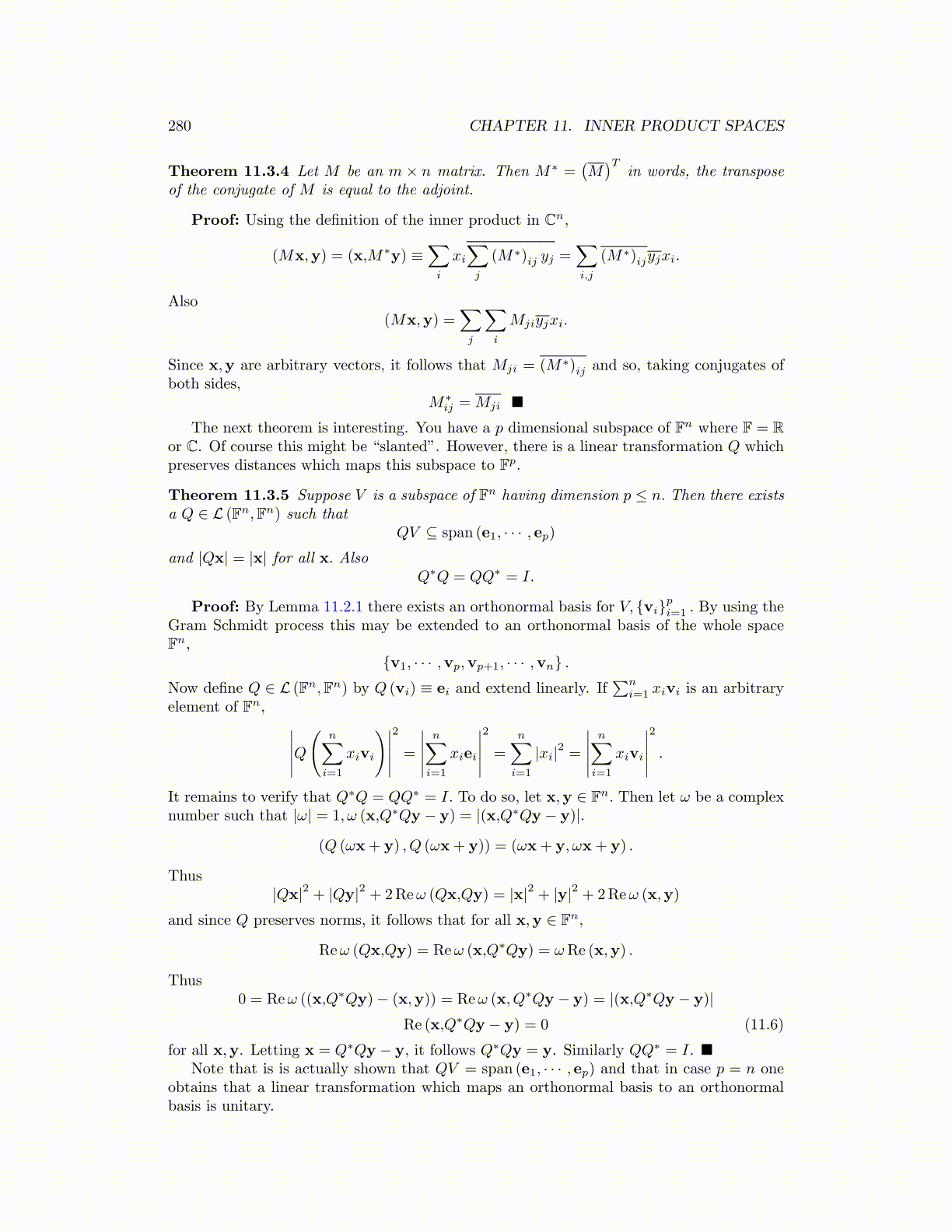
280 CHAPTER 11. INNER PRODUCT SPACES
Theorem 11.3.4 Let M be an m × n matrix. Then M∗ =(M)T
in words, the transposeof the conjugate of M is equal to the adjoint.
Proof: Using the definition of the inner product in Cn,
(Mx,y) = (x,M∗y) ≡∑i
xi∑j
(M∗)ij yj =∑i,j
(M∗)ijyjxi.
Also(Mx,y) =
∑j
∑i
Mjiyjxi.
Since x,y are arbitrary vectors, it follows that Mji = (M∗)ij and so, taking conjugates ofboth sides,
M∗ij =Mji ■
The next theorem is interesting. You have a p dimensional subspace of Fn where F = Ror C. Of course this might be “slanted”. However, there is a linear transformation Q whichpreserves distances which maps this subspace to Fp.
Theorem 11.3.5 Suppose V is a subspace of Fn having dimension p ≤ n. Then there existsa Q ∈ L (Fn,Fn) such that
QV ⊆ span (e1, · · · , ep)and |Qx| = |x| for all x. Also
Q∗Q = QQ∗ = I.
Proof: By Lemma 11.2.1 there exists an orthonormal basis for V, {vi}pi=1 . By using theGram Schmidt process this may be extended to an orthonormal basis of the whole spaceFn,
{v1, · · · ,vp,vp+1, · · · ,vn} .Now define Q ∈ L (Fn,Fn) by Q (vi) ≡ ei and extend linearly. If
∑ni=1 xivi is an arbitrary
element of Fn, ∣∣∣∣∣Q(
n∑i=1
xivi
)∣∣∣∣∣2
=
∣∣∣∣∣n∑
i=1
xiei
∣∣∣∣∣2
=
n∑i=1
|xi|2 =
∣∣∣∣∣n∑
i=1
xivi
∣∣∣∣∣2
.
It remains to verify that Q∗Q = QQ∗ = I. To do so, let x,y ∈ Fn. Then let ω be a complexnumber such that |ω| = 1, ω (x,Q∗Qy − y) = |(x,Q∗Qy − y)|.
(Q (ωx+ y) , Q (ωx+ y)) = (ωx+ y, ωx+ y) .
Thus|Qx|2 + |Qy|2 + 2Reω (Qx,Qy) = |x|2 + |y|2 + 2Reω (x,y)
and since Q preserves norms, it follows that for all x,y ∈ Fn,
Reω (Qx,Qy) = Reω (x,Q∗Qy) = ωRe (x,y) .
Thus0 = Reω ((x,Q∗Qy)− (x,y)) = Reω (x, Q∗Qy − y) = |(x,Q∗Qy − y)|
Re (x,Q∗Qy − y) = 0 (11.6)
for all x,y. Letting x = Q∗Qy − y, it follows Q∗Qy = y. Similarly QQ∗ = I. ■Note that is is actually shown that QV = span (e1, · · · , ep) and that in case p = n one
obtains that a linear transformation which maps an orthonormal basis to an orthonormalbasis is unitary.